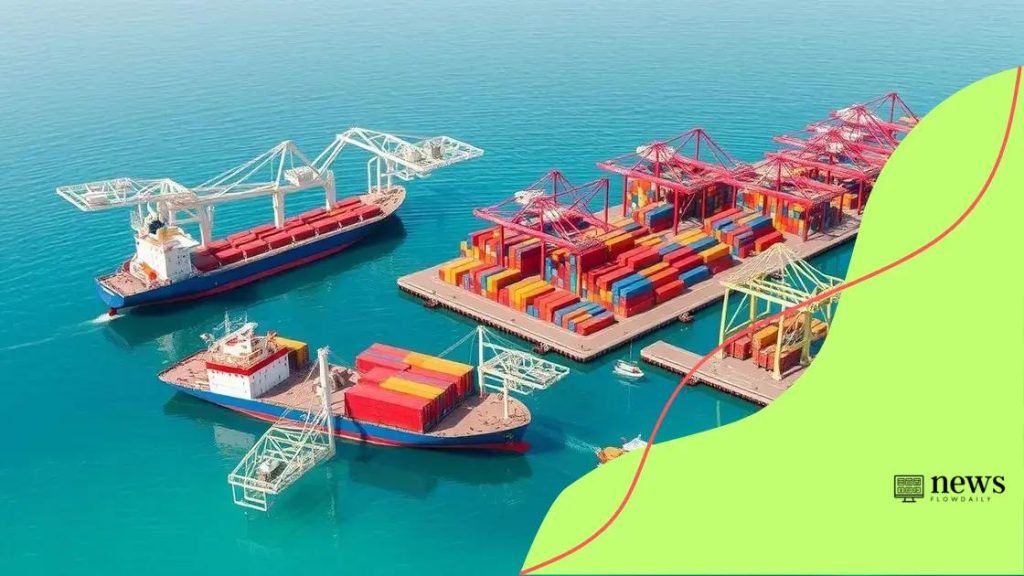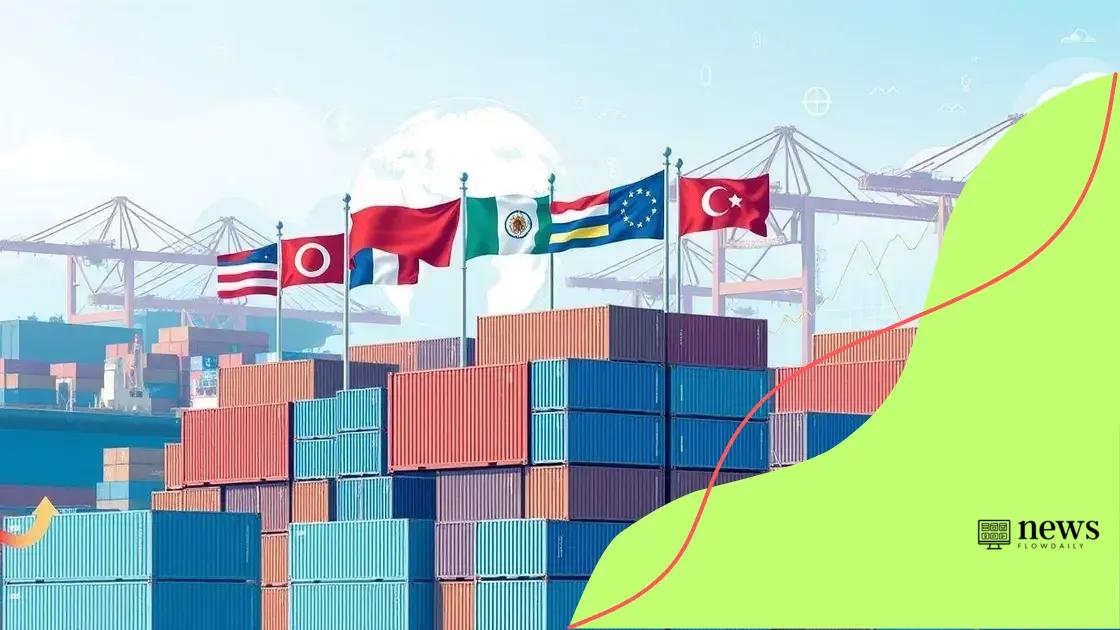Trade deficit concerns: what you need to know today

A trade deficit occurs when a country imports more goods and services than it exports, leading to potential economic challenges such as job losses and increased reliance on foreign products.
Trade deficit concerns are becoming increasingly prominent in today’s economic discussions. Have you wondered how these issues affect your daily life and the global market? This article dives into this complex topic, exploring its causes, impacts, and potential solutions.
Understanding trade deficits: an overview
Understanding trade deficits can seem complicated, but it is essential to grasp how they impact our economy. A trade deficit occurs when a country imports more goods and services than it exports. This situation raises important questions about economic health and sustainability. Let’s explore this topic further.
What is a trade deficit?
A trade deficit indicates an imbalance in a country’s trade. When the value of imports exceeds that of exports, a deficit arises. Understanding this concept is crucial for recognizing the economic dynamics at play.
Causes of trade deficits
Several factors contribute to trade deficits. Key reasons include:
- High consumer demand for foreign products
- Currency valuation
- Trade policies and tariffs
- Domestic production limitations
Trade deficits can be influenced by global economic conditions. For instance, when a country has a strong economy, it may import more, leading to a higher deficit. Conversely, economic downturns can reduce imports.
Impact on the economy
Trade deficits can have various effects, both positive and negative. They can facilitate access to goods and services that are not available domestically. However, persistent deficits might indicate underlying economic issues, such as lack of competitiveness.
In conclusion, understanding trade deficits helps us appreciate their role in the global economy. By recognizing their causes and effects, we can better navigate the economic landscape and make informed decisions.
Causes of rising trade deficit concerns
The causes of rising trade deficit concerns are multifaceted and can significantly impact the economy. Understanding these causes helps to clarify why deficits are more prominent in certain economic cycles.
High consumer demand
One major factor is high consumer demand for foreign goods. When consumers show a preference for imported products, this leads to increased imports, contributing to the trade deficit. This trend is often fueled by greater variety and lower prices available internationally.
Currency fluctuations
Currency value also plays a critical role. A strong domestic currency can make imports cheaper and exports more expensive for foreign buyers, widening the trade gap. When the currency weakens, it can lead to increased export competitiveness but may not fully offset the existing deficit.
Trade policies
Trade policies and tariffs adopted by governments can further influence trade balances. Trade agreements may foster free trade, while protective tariffs can limit imports. Changes in these policies can shift the trade landscape rapidly.
Domestic production challenges
Domestic production limitations can also lead to trade deficits. If a country lacks the capacity to produce certain goods or services, it must rely more heavily on imports to meet consumer needs. This reliance can stem from inadequate infrastructure, lack of investment, or outdated technologies.
In conclusion, rising trade deficit concerns stem from various causes, including high consumer demand, currency fluctuations, trade policies, and domestic production challenges. Recognizing these factors is essential for understanding the broader economic implications.
Economic impact of trade deficits

The economic impact of trade deficits is a significant point of discussion among economists and policymakers. Trade deficits occur when a country imports more goods and services than it exports, creating an imbalance in international trade. This situation can have various effects on an economy.
Positive effects of trade deficits
While trade deficits are often viewed negatively, they can also enhance economic growth. For instance, importing goods allows consumers access to a wider variety of products, often at lower prices. This affordability can lead to increased consumer spending, stimulating economic activity.
Negative effects of trade deficits
On the flip side, persistent trade deficits can lead to substantial challenges. A country may become reliant on foreign goods, which can undermine domestic production. This reliance can result in job losses as local industries struggle to compete with cheaper imports. Additionally, large trade deficits can weaken a country’s currency, leading to inflation as prices for imported goods rise.
- Increased unemployment in certain sectors
- Risk of currency instability
- Dependence on foreign economies
The long-term effects of trade deficits can severely impact national economic stability. Countries with large deficits may see their borrowing costs rise as investors become wary of lending to them. This situation can lead to reduced investment in critical areas such as infrastructure and education.
It’s essential to view both the positive and negative sides when discussing the economic impact of trade deficits. Understanding these facets can help policymakers craft better trade agreements and economic strategies.
Potential solutions to address trade deficits
Addressing trade deficits requires a combination of strategic policies and community awareness. By understanding the potential solutions to address trade deficits, countries can work towards a more balanced trade landscape.
Increase domestic production
One effective approach is to boost domestic production. When countries invest in local industries, they can reduce reliance on imports. This investment can take the form of subsidies or grants for businesses that aim to expand production capabilities. Support for research and development can also help in creating innovative products that meet consumer demand.
Trade agreements
Revising trade agreements is another solution. Countries can negotiate terms that favor local production while ensuring fair trade practices. By implementing tariffs on specific imports, countries can protect local industries from foreign competition, promoting domestic growth.
Consumer awareness and preference
Increasing consumer awareness is crucial. Encouraging consumers to buy local products can stimulate the economy. Campaigns highlighting the benefits of supporting domestic brands may shift consumer preferences positively. When individuals choose to purchase goods made locally, they help reduce the reliance on foreign imports.
Enhanced export strategies
Lastly, enhancing export strategies can provide a way to balance the trade equation. Companies can explore new markets and focus on increasing the quality and competitiveness of their products. By doing so, they can attract more foreign buyers, ultimately reducing the trade deficit.
Implementing these solutions requires cooperation among government, businesses, and consumers. By addressing the issue collaboratively, we can create a more sustainable and balanced economic environment.
Future outlook on trade deficits and economies
The future outlook on trade deficits and economies is a topic of great importance and interest. As global markets evolve, the dynamics of trade deficits are likely to change, impacting economies in various ways. Understanding these potential developments can help individuals and businesses prepare for what lies ahead.
Shifts in global trade patterns
One key aspect of the future outlook is the expected shifts in global trade patterns. As countries work to enhance their domestic production, the reliance on imports may decrease for some nations. This could lead to a rebalancing in trade relationships and affect countries that heavily depend on export-driven economies.
Technological advancements
Technological advancements will also play a significant role in shaping trade deficits. Innovations in manufacturing and logistics can enable countries to produce goods more efficiently. This increased efficiency may reduce costs and enhance competitiveness, potentially leading to improved trade balances.
Economic policies and cooperation
Furthermore, the future will likely see economic policies that emphasize cooperation among nations. Countries may work together to address trade imbalances and create fairer trading environments. This cooperation can facilitate better trade agreements that take into account the interests of all parties, which may help to mitigate persistent trade deficits.
Consumer behavior changes
Changes in consumer behavior will also influence the future of trade deficits. As consumers increasingly prioritize sustainability and local products, there may be a greater push towards buying domestic goods. This shift in preferences could contribute to a reduction in trade deficits over time, as local industries benefit from increased support.
In summary, while the future remains uncertain, the trends in trade deficits and economic relationships indicate a landscape that is continuously evolving. Keeping an eye on global developments, technological changes, and consumer behaviors will be essential for navigating this complex issue.
FAQ – Frequently Asked Questions about Trade Deficits
What is a trade deficit?
A trade deficit occurs when a country imports more goods and services than it exports, creating an imbalance in trade.
What factors contribute to a trade deficit?
Factors include high consumer demand for imports, currency fluctuations, and trade policies that favor imports over exports.
How can trade deficits impact the economy?
They can lead to job losses in domestic industries, currency instability, and an increased reliance on foreign goods.
What are some solutions to address trade deficits?
Solutions include boosting domestic production, adjusting trade agreements, promoting consumer awareness of local products, and leveraging technology for efficiency.





